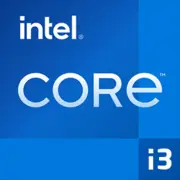Intel Core i3-3240

Intel Core i3-3240: Review and Relevance in 2025
Ivy Bridge Architecture for Budget Systems
Key Specifications: What Does the i3-3240 Offer?
The Intel Core i3-3240 processor, released in 2012, is based on the Ivy Bridge microarchitecture (the third generation of Core). This 22nm chip features two physical cores and supports Hyper-Threading, allowing it to handle up to four threads simultaneously. The base frequency is 3.4 GHz, with an L3 cache of 3 MB and a TDP of 55 W.
Key Features:
- Hyper-Threading: Increases performance in multi-threaded scenarios (e.g., working with office applications).
- Integrated Intel HD Graphics 2500: Supports basic video and simple games, but is insufficient for modern tasks.
- Energy Efficiency: Low thermal output allows for compact cooling systems.
Performance:
According to Geekbench 6 tests (2025):
- Single-thread score — 577 points — acceptable for basic tasks, but significantly lags behind modern budget CPUs (e.g., Celeron G5920 scores ~1200).
- Multi-thread score — 1186 points — a poor rating for multitasking.
Compatible Motherboards: What to Choose?
The processor uses the LGA1155 socket, which limits motherboard options to older models. Suitable chipsets include:
- H61, B75, H77, Z75, Z77 — all discontinued, but still occasionally available for sale as new (price: $60-100, e.g., ASUS P8B75-M).
Selection Features:
1. BIOS: Ensure the board supports Ivy Bridge (not all models on H61 work without a firmware update).
2. Ports: Many boards only have SATA II and USB 2.0, limiting SSD speeds.
3. PCIe Slots: Version 3.0 is only available on Z75/Z77 chipsets, but this is still inadequate for modern graphics cards (e.g., RTX 3050 requires PCIe 4.0).
Tip: If building a system from scratch in 2025, consider modern platforms — even budget LGA1700 or AM5 will offer better prospects.
Supported Memory: DDR3 and Its Limitations
The i3-3240 only works with DDR3-1333/1600 MHz. The maximum volume is theoretically 32 GB, but in practice, most boards support 16 GB.
Recommendations:
- Use a dual-channel configuration (2x4 GB or 2x8 GB) to boost performance.
- DDR3 will be hard to find in new condition by 2025. Prices for an 8 GB module are $25-35 (new, e.g., Kingston HyperX Fury).
Important: No support for DDR4/DDR5 — this is critical for modern games and applications that require high bandwidth.
Power Supply: How Much Wattage Do You Need?
With a TDP of 55W, the i3-3240 does not require a powerful PSU. However, when assembling a system with a discrete graphics card, consider its power requirements:
- Integrated Graphics: A 300-400W PSU is sufficient (for example, be quiet! System Power 10 400W — $45).
- Discrete Graphics Card: For a GTX 1650 (TDP 75W), a PSU of 450-500W is necessary (Corsair CX450 — $55).
Tip: Don’t skimp on the PSU — older models often degrade. Choose units with an 80+ Bronze certification.
Pros and Cons of the i3-3240 in 2025
Pros:
- Low Cost: A used processor can be found for $15-25.
- Energy Efficiency: Suitable for compact PCs or home servers.
- Compatibility with Windows 10/11: Works with current OS (with limitations).
Cons:
- Outdated Architecture: Lags in IPC by 40-50% compared to modern Core i3s.
- No NVMe or USB 3.1 Support: Limits peripheral speeds.
- Weak Multi-threading Potential: Struggles with rendering or streaming.
Use Cases: Where is the i3-3240 Still Relevant?
1. Office Tasks: Working with documents, browsers, Zoom.
2. Multimedia: Watching videos in 1080p (4K not supported).
3. Retro Gaming: Running games from the 2010s (e.g., Skyrim, GTA V on low settings).
4. Home Server: File storage or media center based on Linux.
Practical Example: A user built a PC using the i3-3240 + 8 GB DDR3 + 240 GB SSD for their parents — the system quickly launches the browser and office applications.
Comparison with Competitors
AMD Phenom II X4 965 (2010):
- Pros: 4 physical cores.
- Cons: Higher TDP (125 W), weaker in single-threaded tasks (Geekbench 6 Single Core ~350).
Modern Counterparts (2025):
- Intel Celeron G5920 (LGA1200): 2 cores, 4 threads, Geekbench 6 Single Core ~1200, priced at $50 (new).
- AMD Athlon 3000G (AM4): 2 cores, Vega 3 GPU, DDR4 support — a better choice for budget builds ($60).
Conclusion: The i3-3240 falls behind even new budget CPUs but has an advantage in price on the used market.
Practical Assembly Tips
1. Use an SSD: A SATA SSD (e.g., Kingston A400 480 GB — $35) will speed up system performance.
2. Check the BIOS: Update the motherboard firmware for stability.
3. Don't Overpay for Memory: DDR3 is more expensive than DDR4 due to scarcity — better to buy used.
4. Choose a Graphics Card: If gaming is needed, look for a GTX 1050 Ti (used, $80) — it doesn’t require additional power.
Important: Building with the i3-3240 is justified only if free/cheap components are available.
Final Conclusion: Who Is This Processor Suitable For?
The Intel Core i3-3240 in 2025 is a niche solution for:
- Upgrading Old PCs: If the motherboard and memory are already in place.
- Building Ultra-Budget Systems: When the budget is tight at $100-150.
- Retro Computer Enthusiasts: For experimenting with old hardware.
Why Not Use It for a New Build? Modern processors priced at $50-70 offer double the performance, support for DDR4, and NVMe.
If you're looking for a temporary solution or want to revive an old computer — the i3-3240 can still serve you. However, for future upgrades, plan to transition to modern platforms.
Basic
CPU Specifications
Memory Specifications
GPU Specifications
Miscellaneous
Benchmarks
Compared to Other CPU
Share in social media
Or Link To Us
<a href="https://cputronic.com/index.php/cpu/intel-core-i3-3240" target="_blank">Intel Core i3-3240</a>